Thursday 23 February 2023
MITIE asked me to contribute to their 2023 Net Zero Navigator and speak at a breakfast briefing on net zero on the 22nd February. Here are my remarks.
Well here we are at an event looking forward to what may happen in 2023, but we are already more than 10% through the year. It is good to stop and take stock of where we are and where we are going but in the world of energy and infrastructure 12 months is far too short a period. Even with epoch changing events like the invasion of Ukraine, real change happens over much longer periods. And even with events or shocks like that, like the oil shocks of the 1970s or the 2008 global financial crisis, it is only over time that peoples’ thinking changes, organisations change strategy, and ultimately investment decisions are made that shift technologies, infrastructure, and the way we live our lives in a different direction to the one they had been on prior to the change. We can’t really see the effects of those shocks for many years and even decades.
In February 2022, here in the Shard at a MITIE event like this – which was notable as it was the first in person meeting after lockdowns – I made five points which are worth reiterating.
- Net zero is a transition, one that is now driven by investors as much as anyone
- It is not easy – it needs clear leadership and even unreasonableness from business leaders.
- Don’t accept what the vendors are saying – push back and drive new solutions – make them think.
- Think systems rather than components.
- Consider multiple benefits of projects and particularly how they link to the strategic aims of the organisation.
I still stand by those five points and we can discuss them. But when MITIE asked me to think about 2023 and the trends around net zero several other things came to mind and I want to explore them a bit. I am sure that interaction with this audience will help develop the ideas further. I won’t cover all eight of the headlines in the pre-event publicity, just one or two of them, but hopefully you won’t hold that against MITIE.
First of all there is no longer any doubt that we are in the middle of a major energy transition towards renewables. There is still some opposition, particularly from the right-wing nut jobs who think that solar and wind are all about being ‘woke’ and that it will leave us all poorer and living in the cold and the dark. But these people are like the anti-car protestors at the start of the twentieth century who passed laws that said you had to have a man with a red flag walking in front of the car – they will be run over by history and laughed at.
We may also still be having slightly more sensible arguments about the edges of the energy transition, whether or not we should have nuclear power for example or how long do we need gas as a flexible generation source, but we are all clear that there is a global energy transition going on and it is all about decarbonisation, decentralisation and digitisation. We may also have periods when the transition appears to go backwards, for example switching on coal generators because of the effects of the terrible war in Ukraine, but the transition is now unstoppable.
Most of what is written about and spoken about is what I call phase one of the transition and what it seems to me to be happening now is that the emphasis is switching from phase 1 of the transition to phase 2. Energy transition phase 1 is all about energy supply – and mostly power supply – and energy transition phase 2 is all about energy demand.
Phase 1 was all about large-scale centralised power generation. Here in the UK phase 1 really started in 1990 with the introduction of the Non Fossil Fuel Obligation and the first wind farm at Delabole with its 400 kW wind turbines – we have come a long way in 30 years and we now have 13.7 GW of offshore wind operational and 13.7 GW in construction, with a pipeline of 100 GW – a totally amazing achievement – 100 GW is of course more than the total capacity of the grid, and we have offshore wind turbines of 12 to 15 MW each. When I was working on some of the earliest wind farms in 1990/91 such numbers would have been unimaginable which shows that although change is incremental over a year, it is really significant over 3 to 4 decades.
Things are not entirely over yet but it is clear that achieving scale has brought the cost of renewables, particularly solar and wind, down to the point where in most global markets, most of the time, they are the cheapest way of generating power. incumbents will continue to fight back but the writing on the wall is clear. There may be resistance but when it comes to economics ‘resistance is futile’. Of course there will continue to be a role for gas as flexible generation, but even that will come under threat as the cost of storage drops and we perfect other storage technologies other than lithium ion batteries such as liquid air storage and compressed air or hydrogen in salt caverns.
Of course the other big fight in phase 1, which is not yet resolved and is only now getting under way, is all about heat – where things are not so advanced as in power. For domestic heat the incumbent gas industry is still insisting that hydrogen in the gas main and hydrogen boilers are the way to go – this makes no sense at all thermodynamically or economically and is typical incumbent behaviour. The hydrogen industry is very good at employing lobbyists and PR but as Richard Feynman said: “For a successful technology, reality must take precedence over public relations, for nature cannot be fooled”. The future is electric.
And talking about the future being electric – the future of mobility is also electric. There may be situations and limited windows of time where alternative fuels – but not hydrogen – make sense but even large trucks will be electrified. Aviation of course is different but even there, speaking as former pilot and life-long aviation geek, it has been amazing to see how quickly electric aviation has become a thing. It really was still considered impossible ten years ago. Of course, for long haul passenger aviation, which is not going to go away, synthetic aviation fuel is the way to go and great strides are happening in that area.
So if energy transition phase 1 is all about supply of energy, energy transition phase 2 is all about demand, that means that it is focused on the users i.e. you and me, whether that is at the scale of a factory, an office building or an individual home. It is all about the technologies, the behaviours and the organisational and financial structures we employ when we procure and utilise energy.
In 1980 Alvin Toffler, the futurist, coined the word ‘prosumer’ to mean someone who both produces and consumes and to a certain extent it has become a cliché as more and more of us generate our own power through solar PV.
The second word that encapsulates this phase of the energy transition is ’convergence’. This means the bringing together of multiple technologies to produce energy services. In 2020 we worked with EESL, our Indian partner, to develop the convergence business model for India which involves a package of small scale, 1 to 5 MW solar, battery energy storage systems, EV chargers, LEDs, and induction cooking stoves for agricultural communities in India where they now have grid power but it is intermittent. Given that power prices are heavily subsidised in rural India the economic case is a bit different to here in that the Convergence package can provide 24/7 power at a total service cost less than the subsidies that the distribution companies have to pay. There is potential for tens of GW of these systems in India and they are now being deployed.
Why is this example from rural India relevant to our market? Because we have the same trends of cost reduction in solar and batteries and these trends, plus grid constraints and the need to install new infrastructure such as EV chargers, mean that when you do the maths and factor in ancillary services you can supply power at less than grid cost, ensure that it is truly green power, and have long term certainty over power prices – all of which is highly attractive. This convergence model, bringing together local on-site or nearby renewables, batteries and energy efficiency – effectively micro-grids and mini-grids – represents the next big wave of investment.
So what does energy transition phase 2 really mean?
First of all it is clearly based on self-generation – the most you can do given site constraints. This should be PV as far as possible (and increasingly will be) or it could be gas CHP etc. – remember this is a transition – and it can either be on-site or off-site. Secondly it is also about building in flexibility so that means being able to modulate load, up as well as down, which either means modulating equipment of various types and/or storage. Essentially we are moving to the world of Distributed Energy Resources (DERs)and every single piece of energy using equipment, whether it be a motor, a cooling plant, or even a lamp, can become a smart, controllable DER. And every DER can be used to provide energy services to the end user but also back to the grid.
Phase 2 is also about more than just self-generation and changing our energy demand infrastructure. It is also about changing our mental, organisational and financial structures. To take this approach requires a shift in mindset. The traditional mindset is that energy comes out of the cable or the pipe and what we use is simply a function of the technology and the production of whatever we are making or the use of the building – it is an uncontrollable variable. This is a very passive mode whereas what you need in today’s world is an active mode. It means taking responsibility in areas that traditionally you didn’t as an energy consumer. It also requires new capacities and skills within the organisation, or in your suppliers, to design, develop, install and run a set of flexible DERs as part of, or alongside, your basic business process. Essentially you have to become like an asset backed green energy trader – and to get there you have to have a developer mentality.
Phase 2 of the energy transition is also about achieving much higher levels of energy efficiency. My blog is called ‘only eleven percent’ because that is the global level of efficiency from primary energy to useful energy services which is a pretty shocking number. There are still massive opportunities to improve energy efficiency through better management of what we have, and investing with energy efficiency in mind.
Two examples on the former – better management of existing assets. Everybody was going on about the gas crisis because of Ukraine and it turns out that nearly every condensing boiler in the country is set at high flow temperature and therefore not condensing. Simply turning down the flow temperature doesn’t affect comfort and can reduce consumption by 6-8%. Incredible but we let that continue for twenty to thirty years. And an example from schools, where sending out cheap stick on the wall sensors effectively provided a cheap energy management system – lo and behold the data showed the heating was operating all weekend when the school was empty. Basic stuff but still prevalent. You have to get the basics right first before you can consider sensible investment. Then when you do invest there is potential for profitable energy efficiency everywhere.
Every investment should critically examine this potential but usually it doesn’t. We all know that every day investments are being made that lock in higher than needed energy use – either through ignorance, indifference or other pressures. We need to ensure energy efficiency is properly assessed whenever there is any investment that uses or affects energy use. We are working with the Energy Efficiency Financial Institutions Group to help banks and investors operationalise this in what is called the energy efficiency first principle, which is EU policy.
As well as acting more like a hard nosed asset backed energy trader you also have to become more responsible for all the other impacts of your energy use. One really important subject that is rapidly rising up the agenda is biodiversity. Personally I see loss of biodiversity as being more threatening than climate change. We can probably adapt to higher temperatures, albeit at very high high financial and human cost, but if we don’t have any bees left to pollinate crops we are really in a bad way. So how does that link to energy transition phase two? Well let’s say you have the opportunity to build a PV plant, or sign a PPA with one. That is great. You are making a positive impact on the energy transition and adding to clean energy infrastructure. Well done.
But……is it one of those monolithic PV farms that wipes out good land and doesn’t do anything to increase biodiversity i.e. the standard type being offered today? Or is it one that has mixed land use and is designed to positively improve biodiversity? You get to choose. Do you choose greater biodiversity or do you not care and act like the water companies bosses who put profit above all else and think it is ok to discharge sewage into rivers? Just to make the decision more interesting, soon, if not already, the biodiversity enhancing PV farm will become worth more than a conventional one because financial institutions are recognising the need to invest in biodiversity, and will be increasingly required to do so – and guess what, they can’t find enough projects to invest in. So if you are building a PV plant, or even signing a PPA, think about the biodiversity. And what’s more think about the social impact on the community. By the way, none of this is easy but it is important.
The one big thing that has really changed around net zero in the last few years is the pressure from investors of all sorts to implement changes directed towards addressing climate change. I can’t over state this fundamental shift in the investing world, yes you can sceptical and talk about greenwashing and ESG washing – both of which definitely exist – but the pressure is real. It is driven primarily by regulatory and reporting changes such as TCFD, the EU Taxonomy, SFDR and others, as well as risk assessment. Every fund and every investor is affected by these changes, irrespective of any human or moral position they may or may not have, and that pressure is coming down on companies. When the money talks stuff happens.
Every board I sit on or advise is having to react and come up with plans and reporting on net zero. At the top end of companies there is the capacity to deal with it but in the middle range – even within listed companies – and even more in SMEs there is a need for help, the kind of help that my company EP Group provide, or MITIE can provide.
As I said last time I was here – this shift in the financial world gives me optimism as at the end of the day money counts and people tend to do what is needed to get the money.
When we think about changing our infrastructure toward the prosumer and convergence models and financing them we again need to shift mental models. The kind of distributed energy assets we are talking about are too small for traditional infrastructure investors who think in terms of high hundreds of millions if not billions. But a new kind of investor is emerging who sees the potential of funding these kind of projects, not as a one off but as a portfolio, and hundreds of assets across portfolios could reach the scale needed by institutional investors. Some investors are also looking at funding a new type of developer that can develop across technologies in the convergence model.
For big energy users, like the ones we have in the room, they have the portfolios and they have some of the expertise, but they don’t necessarily want to fund the capital – and they probably shouldn’t because it is an infrastructure return and they can get better returns in their core business. To address this imbalance we need new types of partnerships in which customers provide the energy demand – possibly coming together – and infrastructure investors provide the capital through new kinds of energy service providers. We see these new models beginning to emerge.
So to sum up:
- We are now entering phase 2 of the energy transition, a phase in which the focus will be more on localised energy demand than on large scale supply options
- Phase 2 will be about becoming a prosumer and involve convergence of technologies to provide energy services to consumers and the grid
- Phase 2 needs an adjustment in our thinking and taking responsibility for our energy use and supply – and including many other aspects such as biodiversity
- New models of energy services will be funded by infrastructure type investors.
None of this is magically going to happen in 2023 but we clearly see the green shoots of these kinds of developments. As William Gibson said, “the future is here, it is just not evenly distributed yet”. When I play forward ten, twenty or thirty years I think we will see as big a change as we did in energy transition phase 1 from the 1990s to 2023.
And of course I will be happy to discuss these ideas with you now, or in private afterwards. At EP Group we are committed to helping companies and investors think through the options and developing these kind of projects of the future.
Thursday 27 October 2022
An update on ep group’s evolution
At ep group we are best known for our work in energy efficiency, energy services, and the financing of energy efficiency. This work is based on both our experience over many years but also our belief that improving energy efficiency is a critical but still relatively neglected part of the energy transition. We have always been clear, however, that transitioning to a cleaner, more equitable energy system is just one part of the massive challenge we all face in building a more sustainable, and ultimately regenerative economy. Every day, as well as the effects of climate change we see more evidence about the loss of bio-diversity and many other environmental problems such as plastic waste, water pollution etc, problems that affect us all. At the same time, we see social problems such as lack of equal opportunities, as well as poor governance of organisations and countries as being major issues that affect us all and make us poorer in both an economic and a human sense.
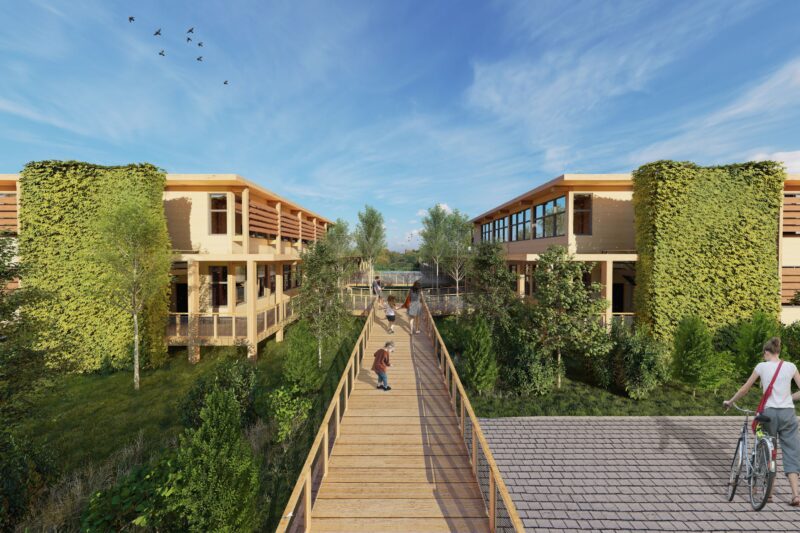
The good news is that there are clear signs of solutions emerging. The rise of interest in stakeholder capitalism, purpose-led companies, impact investing and ESG investing, even allowing for the real problem of ‘ESG washing’, are all positive trends. We see impact investing, investing with an explicit intention to make positive change, along with its corollaries of impact management and impact consuming as the way forward. Our work had always been focused on making a positive environmental impact through improving energy efficiency and when we organised our various companies into ep group we ensured that impact measurement was baked into our operating model. As we were increasingly expanding into other areas we also re-considered our purpose and stated it as follows: ‘to enable maximum impact in the transition to a net zero and regenerative economy in an equitable way’.
It is worth explaining this purpose in more detail. The word ‘enable’ is important as we think maximum impact will be achieved by focusing on enabling many people to have their own impact in their own way, rather than just focusing on our direct impact. This is what Carol Sanford, a leader in regenerative thinking, calls ‘indirect work’. The idea of a ‘net zero’ carbon economy and the need to move towards it to combat climate change is widely understood, but the phrase ‘regenerative economy’ less so. Essentially it means moving investment and resources into systems that restore and regenerate nature, systems that pay attention to quality and well-being and rely on renewable energy flows and the circular economy. The words ‘in an equitable way’ are also vital in this context, much of the modern economy is inequitable, particularly the provision of capital, much of which is extractive, short-term, and not accessible to many people. Being equitable is core to who we are.
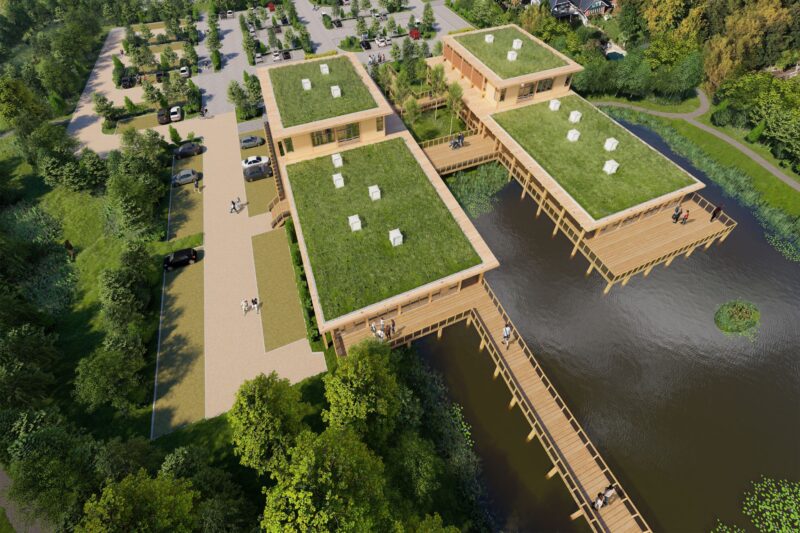
So how are we delivering against our purpose? Our Theory of Change identifies three types of impact we have through our work: increased capacity within organisations to transition to the net zero and regenerative economy; increased investment into net zero and regenerative projects, programmes and companies; and developing and delivering high performance net zero and regenerative projects and programmes in industry and the built environment. Our services, which include: consultancy, research and development; asset management; developing projects; and architecture and design, all contribute to these impacts. Our 2022 impact report, which will be published soon, will summarise some of the impact our work has had across the different businesses.
We have another fundamental belief, and that is mainstream shareholder primacy models of business are clearly part of the problem and that introducing new models of ‘enterprise design’ is a necessary part of the solution in addressing environmental, social and governance problems. Having reviewed different models in use that address the problem, we decided to transition to steward ownership. Steward ownership is based on two principles:
- Self-governance – businesses should be controlled by people working in them.
- Profits serve purpose – profits serve the mission of the company.
Steward ownership will provide a long-term, stable home for the people in the business as well as reward them with a stake in the business.
As well as restructuring we have invested heavily in systems for governance, finance, and impact reporting. Having built our platform the strategy is to scale by agglomeration – bringing into the group other service businesses in adjacent markets that support the transition to a net zero and regenerative economy – and list the company in three to five years. This strategy provides a route to greater value creation and liquidity for business owners, access to cheaper patient capital, the ability to bid for larger projects with large customers, the network effects that can come from working with other parts of the group, and a long-term purpose-led home for their company and their employees.
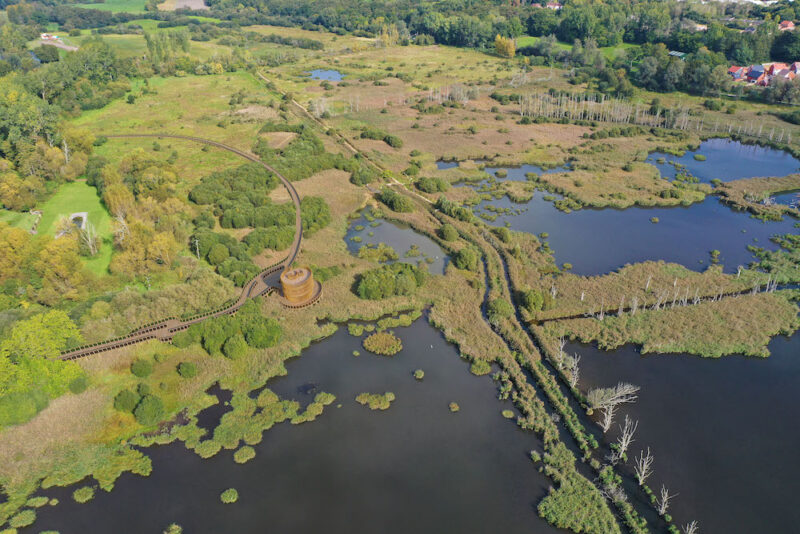
Our approach to bringing companies into the group is to first acquire at least 51% of the company in exchange for shares in ep group. The remaining shares will be purchased on an agreed exit multiple after an agreed time, or when the group lists. It is expected that the founder shareholder(s) will stay active in the business for an agreed period but it is not necessary that they should exit completely.
Companies that we bring into the group should:
- be operating in areas that support the Sustainable Development Goals, particularly SDG 7, SDG 9, SDG 11, SDG 12, and SDG 13
- be operating in areas that are complementary to existing ep group
- be EBITDA positive
- have little or no debt
- have founders seeking value realisation within a defined period
- have a complementary culture.
Our offering has proven to be attractive to business owners and we have a pipeline of companies interested in joining the group. It is also attractive to investors, particularly impact investors who cannot normally access the smaller companies which are helping to deliver the transition to a net zero and regenerative economy.
If you are interested in joining us on our journey building a new type of enterprise, or finding out more about the impact-led investment opportunities we have, do get in touch.
Steve Fawkes
Managing Partner
24 October 2022
Tuesday 4 October 2022
Anyone funding a project, or looking to investor loan money to a project or a company, should consider energy efficiency first.
There are two basic scenarios to think about:
- Energy supply projects or assets
- Energy consuming projects or assets
For all energy supply projects it is possible, and necessary, to ask whether the capital would be better deployed, where ‘better’ is defined as better or the same returns but with greater impact on energy supply and carbon emissions. In many cases investing in energy efficiency may produce better returns, optimize capital across the energy system, and produce more energy services over the life of the investment. Of course developing and implementing energy efficiency projects on the scale of energy supply projects, which are typically in the range of 10s of millions to billions of euros/pounds/dollars is not easy and we need to develop more capacity and know-how in this area.
For any consuming project or asset, which basically means nearly all buildings, manufacturing processes and plants, and all transportation systems, the question to ask is ‘are there opportunities to improve the energy efficiency of this project or asset cost-effectively that are not being exploited?’. Note that cost-effectiveness is defined by the investors’ required rate of return rather than some arbitrary number. Almost certainly there will be opportunities to improve energy efficiency, either by changing the design of the whole thing, or sub-systems within it if it is a new project or asset which is yet to be constructed or by retrofit and refurbishment opportunities if it is an existing asset.
Financial institutions which are committed to net zero, and which therefore should be committed to energy efficiency first, need to be asking these questions of all potential investments or loans. Furthermore, they need to be considering:
- how they can assist project sponsors or developers to bring forward projects in which these questions have already been answered.
- What tools they need to determine whether the answers being given to the questions are robust.
In emerging economies, where demand for basic energy services is growing rapidly, the balance between energy supply and energy efficiency investment may be different than in a mature economy, but the questions should still be asked and global experience shows that there are many opportunities for cost-effective energy efficiency in emerging economies, perhaps even more than in mature economies. Increasing the flow of capital into these opportunities can reduce energy supply constraints and make each dollar of investment into energy supply more effective in meeting energy needs and supporting SDG 7.
Friday 30 September 2022
I was honoured to be invited to attend the recent INSIGHT 2022 event organised by Convergence Energy Services Ltd in Delhi and speak on a panel. The event was sub-titled; ‘International Conference on Sustainable and Innovative Finance for Green and Healthy Transportation’.
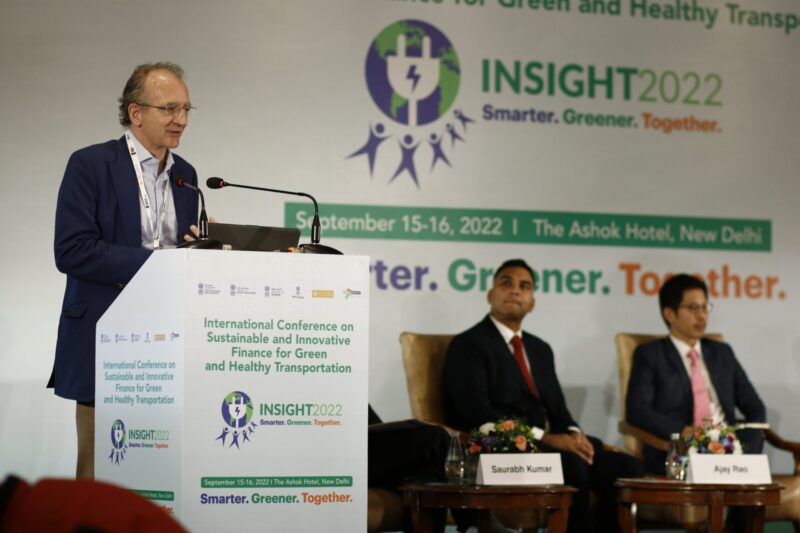
India is committed to decarbonisation and having achieved a lot in scaling energy efficiency and renewables and is now turning to focus on e-mobility. Convergence Energy Services Ltd (CESL), a subsidiary of publicly owned Energy Efficiency Services Ltd (EESL), (with which EnergyPro – part of the ep group – has a JV in the UK), recently ran a tender for 5,450 e-buses, the world’s largest e-bus procurement exercise. CESL aggregated demand across five cities and standardised tender conditions to procure e-buses on a Gross Cost Contract (GCC) basis. Developing the tender required active consultations between transit agencies, all with their own specifications, e-bus manufacturers, financiers, Ministries and government agencies. For comparison, in Europe there are about 10,000 e-buses.
Demand aggregation increased the tender size to 5,450 buses in lot sizes of 465 to 1,500 as opposed to the smaller lots of 300 buses helped OEMs achieve economies of scale. Daily running requirements of 200 km per day, or 70,000 km annually, also helped lower the bidding rates. Batteries account for c.40% of the cost of an e-bus. An assured time of 45 minutes between bus operations allows opportunity charging which meant batteries could be smaller, which helps to reduce costs. Electricity and labour costs were benchmarked to ensure transparency in the bid rates.
The demand aggregation led to a 30% reduction in the bidding prices of the Grand Challenge for 12m AC e-buses compared to GCC rates for CNG fuelled buses in Delhi. For 12m low floor non-AC e-buses are around 35% lower than the rates for 12m standard-floor non-AC CNG buses.
The 5,450 buses under the Challenge are expected to operate around 4.7 billion km over 12 years, saving 1.88 billion litres of fuel and resulting in a reduction of tail-pipe emissions of 3.31 MTCO2e.
The Grand Challenge results are an important lesson for other countries or regions looking to electrify public transport. The approach used by CESL seems to address the four elements of what I call the ‘the jigsaw of energy efficiency finance’, a simple model I developed a few years back after reviewing the global experience of scaling investment into energy efficiency. The jigsaw has four pieces:
Develop pipeline through
- more attractive business models
- Building development and aggregation platforms
Standardisation of
- development process
- technical solutions
- contracts
- systems & under-writing
Provide finance
- project development finance
- long-term project finance
Build capacity in:
- demand side
- supply side
- financial sector
To achieve scale all four pieces have to be put together.
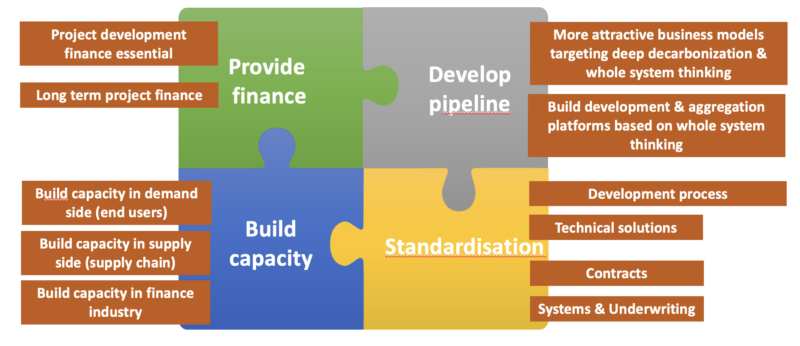
The jigsaw of energy efficiency finance. Copyright EnergyPro Ltd 2018.
In the Grand Challenge the pipeline building and standardisation pieces were performed by CESL, acting as an aggregator of demand and catalyst for getting everyone to agree the standards. Development finance was provided by CESL who were effectively acting as the project developer in this case. Finance for the 5,000+ buses came from the suppliers. CESL were the all important ‘transaction enabler’ to get all the pieces together. CESL also worked to build capacity on the demand side, the supply side and the finance side, something that is continuing.
Given the success of the Grand Challenge a target has been set by Prime Minister Modi of procuring 50,000 e-buses by 2030 and at INSIGHT 2022 there was talk of doing more and tendering 500,000. India has 1.8 million buses of which 140,000 are owned by SRTUs (State Road Transport Undertakings). Electric buses can reduce operating costs by 50% but the buses cost 2-4 times a conventional alternative. Purchasing e-bus services for a 12 year fixed contract reduces the financial and operational risks of bus agencies considerably.
The next stage of the challenge is to work how to finance the larger number of e-buses needed to really scale-up. This will require international capital and probably involve a separate agency with some form of blended capital, carbon finance and with derisking tools such as guarantees to bear some of the risks involved.
CESL’s Grand Challenge is a world leading example of the power of aggregating demand which has scope for replication in different areas including e-mobility and energy efficiency. Huge congratulations to CESL for getting the world’s largest e-bus tender completed.
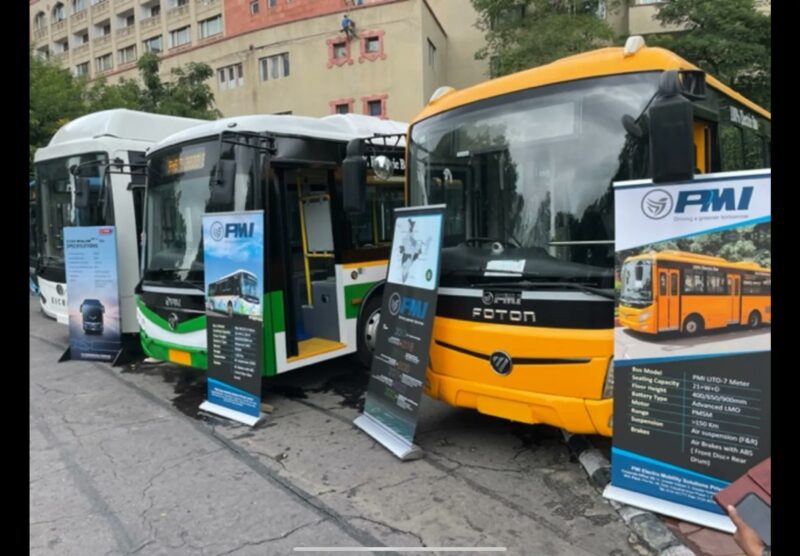
Wednesday 31 August 2022
The war in Ukraine, which now seems as if it will last a long-time, is one of the most important threats we face. Preventing, or in this case, correcting, the illegal annexation of a sovereign country by another country is fundamental and if Russia gets away with it, Europe and the world will be a more dangerous place. As everyone knows Russia can only act like this because of the huge inflows of money that result from selling gas to Europe. I wrote about energy security several times in 2013/14 – particularly when Russia invaded Crimea. I think back then Europe was sending Russia more than €0.5 billion a day (a day!) in return for oil and gas supplies. Just imagine a pile of a half a billion euros being carted off to Russia, (I know it is done electronically in reality).
Of course, energy security is not a new issue. We had the oil crises of 1973 and 1979 which highlighted dependence on oil from the Middle East. Trade is generally a good thing but by being energy dependent a country reduces it’s degrees of freedom of action. It has been good this time round that there has been concerted action in the EU at least to reduce dependence on Russian gas. Improving energy efficiency has always been, and remains one of the most powerful, and potentially quickest acting, levers that we have to reduce energy dependence. Obviously increasing domestic production of energy, of whatever source, is the other lever.
The EU through its RepowerEU initiative aims to bring down consumption by 15% by March 2023. For some reason the UK is almost alone is not responding to the war in Ukraine with a programme of at least encouraging, if not mandating energy saving despite the fact that in the UK 38% of gas is used for domestic heating and we are heading for a very hard winter that will see millions of people and businesses unable to pay their energy bill. Still, the government refuses to give any advice and only continues to issue anodyne press releases saying supplies are not threatened.
One of the really effective, and interesting things that has emerged is how much gas most homes are wasting, even the millions that have condensing boilers. When condensing boilers were introduced they were sold, and ultimately mandated, on energy saving grounds. Now it turns out – perhaps no surprise – that most of them have not been set up properly and are wasting 6-8%. This waste can be prevented by turning down the flow temperature, see here for details.
This conversation about boiler flow temps, which I’m glad to see is being turned into action, is a reminder that good energy management (for organisations or homes) consists of first managing what you have already got and then, and only then, considering investment opportunities, which can either be adding something to an existing system e.g. better controls on a heating system or lighting, or replacing something eg replacing a boiler with a heat pump, or conventional lighting with LEDs.
We learnt the basics of energy management in response to the oil crises of the 1970s (and before that the UK fuel crisis of the late 1940s) but somewhere along the line, as energy prices fell and incomes rose, they were largely forgotten. It is good to see them re-emerging, just disappointing that it takes another crisis.
The fact that homes with condensing boilers can save c.8% of gas consumption through simple re-adjustment of flow temperature shows two things:
1. The potential for cost-effective energy efficiency is still very large. At any one time, the cost-effective potential for reducing energy is probably 25-30% – and that has never changed, it is about ‘slack’ in the system. With higher prices the cost-effective potential increases. That 25-30% can usually be achieved with low cost measures and is before you get to the harder, more expensive stuff. I recently saw examples of schools saving 25%+ through low cost sensors that highlighted times of waste e.g. running heating when the building was closed or very early start times that were not justified by the weather.
2. The gas boiler industry has, with some notable exceptions, been woeful in its quality standards, training & integrity. What was the point of installing condensing boilers and claiming all the savings they were producing when they weren’t most of the time. Improving skill levels is essential, but is so improving basic integrity at senior levels within big organisations.
The idea that the government can’t or won’t do anything to give advice on energy saving is such nonsense, doing so would be an example of leadership, something that current politicians don’t seem to understand. Any information campaign does not have to be ‘authoritarian’ or ‘condescending’ – at the end of the day it is up to people whether they follow the advice but there is a real need for advice.
A case study. Back in the late 1980s I designed & ran an energy motivation programme for 45 of Coventry’s social services homes, mainly elderly people’s homes. These are some of the most difficult facilities to address in a way because: a) they are kept warm (usually too warm) all the time because residents are often sedentary and ‘need’ a high temperature – (or at least that was the belief structure) – and staff are non-technical, and they are rightly focused on their primary mission of administering care, often in difficult circumstances.
With the input from a wide range of stakeholders including the union we designed a motivation programme with a training course that:
1. explained WHY saving energy was important (which was all about budgets then, as it was pre conversations about carbon)
2. explained HOW to save energy, the usual simple tips
3. explained how to read meters (which is never easy) and record consumption (there were no smart meters back then).
Using the meter data we then gave them regular, simple weather corrected feedback (having explained how it worked), and the establishment received a percentage of the proven savings to spend on stuff that benefited the home. Often they spent it on additional simple energy saving measures, like draught proofing, adding a porch, etc., or on little niggly maintenance jobs that they had not succeeded in getting done through the system.
The net result was an overall 6% savings on energy use over a year, with individual savings ranging up to 38%. All of this was with no capital expenditure. The result was financial, energy, and carbon savings and engaged staff.
We developed a simple model which seems to work. In order to create Action, you need 2 things: Knowledge (or know-how) of what to do and the Motivation to do something. Training provides know-how and when done well can increase Motivation. Motivation is also (greatly) increased by Incentive, (which does not have to be financial), and Feedback that shows that the action is having the desired effect. Put those things together and you have effective action.
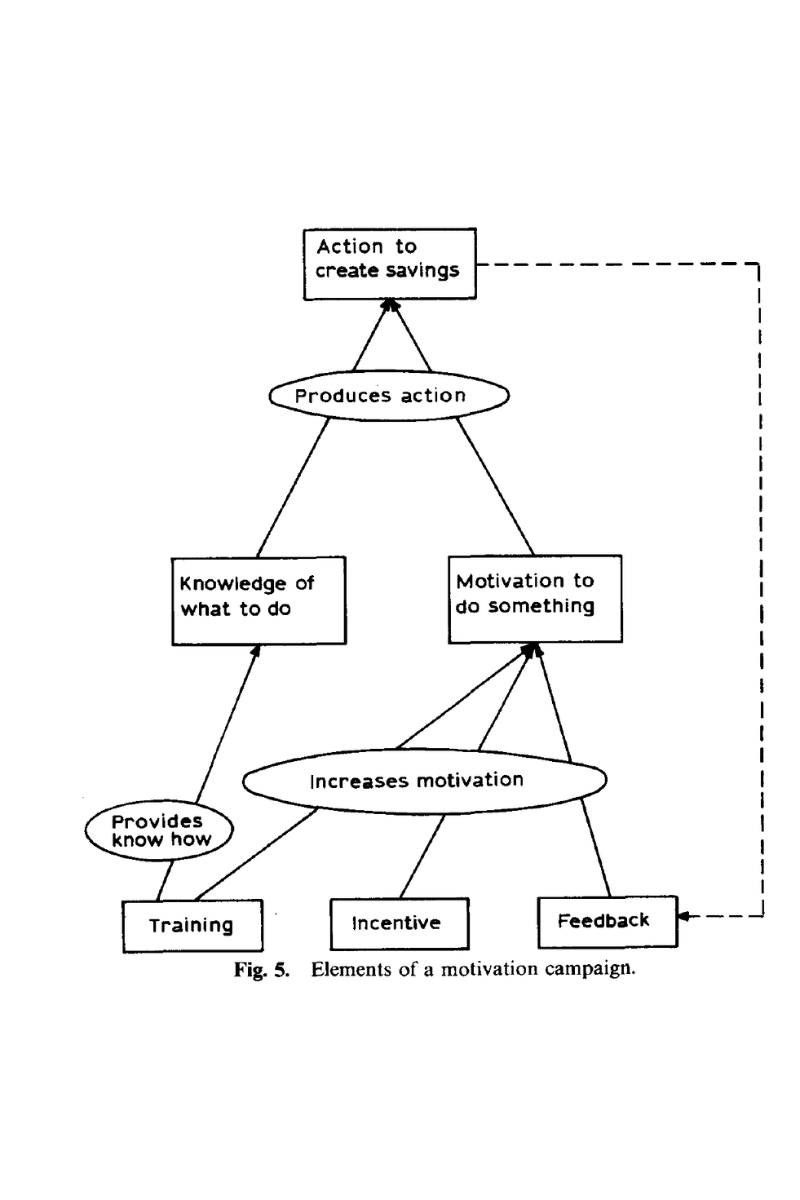
Other motivation campaigns at the time gave a percentage of savings to a charity chosen by the end-users, thus creating a double impact.
If we could do that with basically no technology, other than a spreadsheet, imagine what smart meters and cheap smart sensors can do. The schools saving 25% through smart sensors I referred to above are good examples.
We should be getting our energy management basics right before considering capital projects. Optimising energy consumption first can change what is viable or optimum for the capital projects, as well as reduce capital through techniques such as right-sizing. The differences between the 1980s and now are essentially: better technological options, increased motivation, and decarbonisation of electricity. When considering capital expenditure options the combination of climate change and the war in Ukraine should drive everyone to consider what would once have been considered radical, higher cost options including electrification and deep retrofits, rather than small improvements. At today’s prices many of these measures will be economic, the problem then is how to finance them, particularly in the residential sector. When assessing financial benefits we should also never forget, although most people do, the impact of energy price volatility, which in itself has a financial impact, irrespective of the energy price being made.
We know what to do to reduce dependence on dictators selling fossil fuels, along with all the other negative environmental, economic, and social impacts from their use. Let’s just do it.
The Coventry project is described here.
Dr Steven Fawkes
Welcome to my blog on energy efficiency and energy efficiency financing. The first question people ask is why my blog is called 'only eleven percent' - the answer is here. I look forward to engaging with you!
Email notifications
Receive an email every time something new is posted on the blog
Tag cloud
Black & Veatch Building technologies Caludie Haignere China Climate co-benefits David Cameron E.On EDF EDF Pulse awards Emissions Energy Energy Bill Energy Efficiency Energy Efficiency Mission energy security Environment Europe FERC Finance Fusion Government Henri Proglio innovation Innovation Gateway investment in energy Investor Confidence Project Investors Jevons paradox M&V Management net zero new technology NorthWestern Energy Stakeholders Nuclear Prime Minister RBS renewables Research survey Technology uk energy policy US USA Wind farmsMy latest entries
- And yonder shines Aurora’s harbinger
- The journey to net zero
- The RetroMeter project: using metered energy savings to make energy efficiency more investable
- An overview of the ESCO industry
- Applying Energy Efficiency First in financial institutions
- Getting to grips with the complexities of industrial decarbonisation using soft systems
- Back in Brum – home of the Energy Service Company


